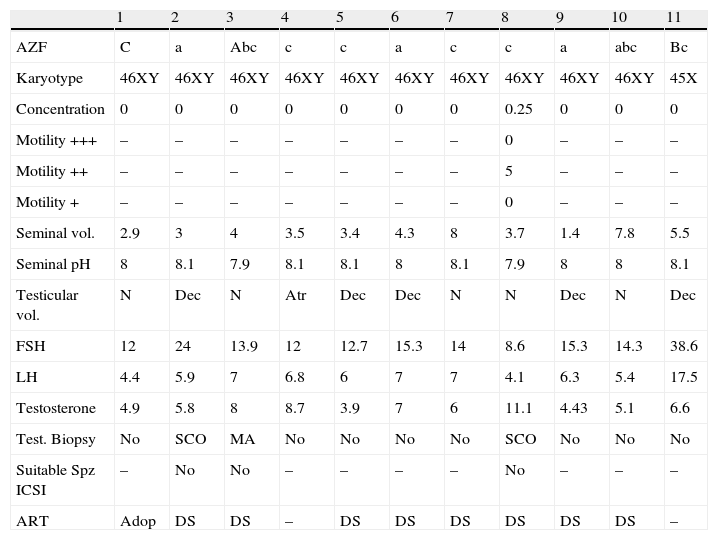Approximately 10% of patients with non-obstructive azoospermia and 5% with non-obstructive severe oligozoospermia carry AZF region microdeletions (AZoospermic Factor) in the Y chromosome. The aim of this study is to analyze the clinical and pathological findings in this group of patients and compare them with the previous evidence.
Materials and methodsRetrospective study of 11 patients with diagnosis of azoospermia or oligozoospermia was performed and found the presence of AZFa, AZFb, and AZFc microdeletions or any combination of them.
ResultsMicrodeletions of AZFc region were found in 45% of cases, AZFa in 33% and a 10% showed a deletion of the three regions (a, b and c). 91% of them demonstrated azoospermia with low testicular volume in 62.5% cases.
ConclusionMicrodeletions of AZF regions are associated with azoospermia and a low expectation of sperm retrieval in testicular biopsy. On the other hand, they seem not to be related with significant modifications on the hormone profile.
Aproximadamente un 10% de los pacientes con azoospermia no obstructiva y un 5% de pacientes con oligozoospermia severa presentan microdeleciones en las regiones azoospermic factor (AZF) del cromosoma Y. El objetivo principal de este estudio es analizar las características clínicas y patológicas de estos pacientes y compararlos con la literatura previa.
Material y métodosEstudio retrospectivo de 11 pacientes con diagnóstico de azoospermia u oligozoospermia y presencia de microdeleciones AZFa, AZFb, AZFc o sus combinaciones.
ResultadosLa microdeleción en la región AZFc apareció en un 45% de pacientes, AZFa en el 33% y un 10% presentaron mutación en las 3 regiones analizadas (AZFa, b y c). El 91% de los pacientes con estas microdeleciones presentaron azoospermia con un volumen testicular disminuido en el 62.5%.
ConclusiónLas microdeleciones de la región AZF se asocian a azoospermia y una baja expectativa de recuperación de espermatozoides en la biopsia testicular, sin alterar significativamente la función hormonal.
Artículo
Comprando el artículo el PDF del mismo podrá ser descargado
Precio 19,34 €
Comprar ahora








